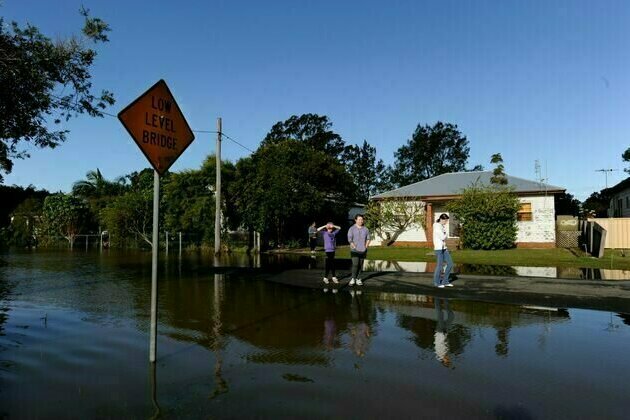Yes, Australia needs new homes - but they must be built to withstand disasters in a warmer world
The Conversation
19 Feb 2025, 00:29 GMT+10

Australia's housing crisis has created a push for fast-tracked construction. Federal, state and territory governments have set a target of 1.2 million new homes over five years.
Increasing housing supply is essential. However, the homes must be thoughtfully located and designed, to avoid or withstand natural disasters such as bushfires, floods and cyclones.
Recent severe weather, including floods in Queensland and severe storms in north-east Victoria, underscore the growing vulnerability of Australian homes. As climate change worsens, the risk becomes ever-greater.
Our new research examined how disaster risk informs housing location and design in New South Wales, Victoria and Western Australia. We spoke to planners, developers, insurers and housing providers, and found crucial problems that leave communities exposed.
Australia's towns and cities are increasingly affected by natural disasters. The consequences extend beyond physical destruction to social, psychological and health effects. Disasters also harm the economy.
Despite this, government housing policies and strategies often fail to adequately focus on natural disasters.
Accurate, up-to-date information is crucial when seeking to protect new homes from natural disasters. Informed decisions typically require three types of data:
foundational: relating to vegetation, landscape features, weather, climate change and building characteristics such as height and materials
hazards: the risks of different disaster types such as historical flood data, maps of bushfire-prone areas and the recurrence of cyclones
vulnerability: the potential and actual impacts of natural disasters such as building damage, fatalities and injuries, displacement, psychological and health impacts and insurance losses.
Our research, for the Australian Housing and Urban Research Institute, examined how data could be better used and shared to plan and deliver new housing and protect Australians from disasters.
We started by identifying what data was available in Australia for bushfire, flood and cyclone risk. Then we examined who owned and managed the data and how it was, or wasn't, shared.
The next step was to explore how decision-makers use the data to assess disaster risks for new housing. This involves interviews, workshops and questionnaires with:
government planning agencies (both state and local government)
housing providers (public and not-for-profit/community housing)
housing and land developers (private and public)
banks and insurers.
Overall, we found data on disaster risk was fragmented and inconsistent across multiple agencies, and not regularly updated.
Decision-makers in state and local planning agencies often cannot access accurate information about disaster risk. This means they lack the power to restrict housing in areas prone to bushfires, floods or other extreme events.
Flood hazard data is particularly problematic. One planner from Queensland described it as "patchy, of variable quality and currency and not always open source" - the latter meaning it was hard to access.
Many households only learn about their disaster risk when discovering their homes are uninsurable or premiums are prohibitively high. Others become aware of the problem when premiums rise with an existing insurer.
A community housing provider told us:
I think the way people are finding out about risk now is by their insurance policies going up. That's the market reality. When they get an increase in their insurance policy next year, that will wake them up that they are actually in a high-risk area.
Data held by emergency service agencies and insurers is mostly inaccessible to planners, developers and households due to privacy and commercial sensitivities.
However, this information is crucial. Government agencies should establish protocols to enable data-sharing while protecting privacy and commercial interests.
A recent report suggested only 29% of Australian home buyers know the disaster risks associated with the homes they live in.
Disclosure statements are required by the vendor (seller) when marketing their house or land for sale. These vary between states and territories and, in most cases, do not compel the owner to reveal all known risks.
For example, in Victoria, a vendor is required to disclose whether the land is in a designated bushfire-prone area, but not whether it is exposed to flooding.
What's more, a vendor motivated to sell a house is probably not the best source to provide accurate, impartial information about its exposure to disaster. This is better left to an independent entity such as a local council.
Thorough investigations into a home's disaster risk is usually at the discretion of the buyer.
Making this information readily available to prospective homebuyers prior to purchase would allow more informed consumer decisions. It would also pressure governments and housing suppliers to address disaster risks.
Australia urgently needs a national framework to ensure data on housing and disaster risk is comprehensive, current and embedded in housing development decisions.
The federal government's Digital Transformation Agency could establish and implement this system, with input from state and local governments.
Technology known as "spatial digital twins" could also vastly improve how disaster risk is assessed and communicated. These tools enable users to pull together and arrange large amounts of data, to visualise it in the form of models.
For example, a spatial digital twin could combine real time flood sensor data with historical flooding patterns to predict and visualise flood risks before they occur. Federal and state governments are already investing in such technology.
Australia's push to increase housing supply must be matched with a commitment from governments to ensure the homes are safe, resilient and sustainable in the face of our changing climate.
Addressing the housing crisis isn't just about numbers - it's about making sure homes are built in the right places, with the right protections, for the long-term safety of communities.
 Share
Share
 Tweet
Tweet
 Share
Share
 Flip
Flip
 Email
Email
Watch latest videos
Subscribe and Follow
Get a daily dose of Australian Herald news through our daily email, its complimentary and keeps you fully up to date with world and business news as well.
News RELEASES
Publish news of your business, community or sports group, personnel appointments, major event and more by submitting a news release to Australian Herald.
More InformationInternational
SectionWorld mourns loss of Pope Francis, dead at 88
THE VATICAN - The world is in shock and mourning on Easter Monday as it woke to the news that Pope Francis had died. Having recently...
Ex NYC police officer sentenced for illegal work tied to China
NEW YORK CITY, New York: A former New York City police sergeant, Michael McMahon, was sentenced this week to 1.5 years in prison. He...
U.S. halts Equinor's Empire Wind Project over environmental concerns
WASHINGTON, D.C.: U.S. Interior Secretary Doug Burgum has ordered a stop to construction of Equinor's Empire Wind project off New York's...
Asian nations boost US energy buys amid trade tensions
SINGAPORE: Amid rising trade tensions, several Asian nations are stepping up energy purchases from the U.S. in hopes of easing tariff...
US turns over border area to US Army to prevent crossings
WASHINGTON DC - In a bid to combat illegal border crossings, the Trump Administration has enacted an emergency transfer of some 110,000...
Photo of 9-year old Palestinian double-amputee wins top honors
More than 200 journalists and news photographers, together with family members, have been killed in Gaza in the last 16 months. Despite...
Sydney
SectionAustralian lawmakers hunt alleged criminal from Ireland
The Australian Federal Police (AFP) are appealing to the public for assistance in locating Michael Connors, a 25-year-old Irish national...
Sydney Sweeney to produce movie adaptation of Sega's 'OutRun' video game
Washington DC [US], April 22 (ANI): Actress Sydney Sweeney is set to produce the adaptation of Sega's 1986 arcade driving adventure...
Australia had a national reckoning over domestic violence, but where's the focus this election?
For most of this federal election campaign, politicians have said very little about violence against women and children. Now in...
What would Australia be willing to go to war over? This needs to be made clear in our defence strategy
In 2024, the National Defence Strategy made deterrence Australia's primary strategic defence objective. With writing now underway...
Former Pakistan head coach Gillespie involved in financial dispute with PCB
New Delhi [India], April 21 (ANI): Former Pakistan head coach Jason Gillespie and the Pakistan Cricket Board (PCB) are involved in...
Jacob Elordi talks humanising Dorrigo Evans in 'The Narrow Road to the Deep North'
Washington [US], April 21 (ANI): Jacob Elordi, known for his roles in 'Euphoria' and 'Saltburn', has returned to his homeland for a...













